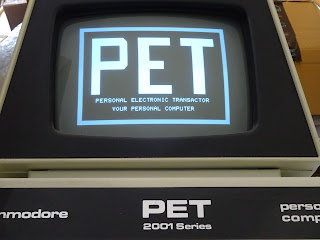This is an old post, preserved for reference.
The products and services mentioned within are no longer available.
- W65C02S CPU running at 1MHz
- 32K RAM
- 20K BASIC / OS, 2x4K option ROMs
- Original BASIC 1/2/4
- Custom Mini PET BASIC 4
- Built in ROM/RAM self test
- Compatible with most Commodore PET software and peripherals, with the following exceptions:
- The screen is 40 columns only, so any 80 column (mainly business) software will not look correct on any 40 column PET
- There is no CRTC chip, so any software (mainly later demos) that needs a CRTC will not work
- The CPU socket is not pin compatible with the original NMOS 6502, so nothing that plugged into the 6502 socket will work.
- There are no internal power headers (but these were generally only used in conjunction with the CPU socket above).
- 2x W65C21N and 1x W65C22N providing the following IO ports
- IEEE-488 bus for disk drives / printers
- Userport with 8 bit parallel port
- 8x10 keyboard matrix
- 2x Commodore Datasette connectors (compatible with C2N and 1530)
- Piezo sounder connected to CB2 (as required by Invaders and as fitted to later PETs)
- 1K video RAM providing 40x25 character based display, via one of the following:
- Composite video, monochrome PAL / NTSC
- PET 9" monitor
- PET 12" monitor
- Single 9V DC supply from external supply or PET transformer, 170mA
- Self assembly kits.
- Modest soldering skills are required.
- All through hole parts.
- All brand new and currently in production.
Kit A - Standalone
This is the version of the Mini PET which is stand alone PET compatible computer with it's own keyboard. This would normally be used with a 9V DC power supply and would drive a composite video TV or monitor.
This version would normally be used to replace the mainboard in a Commodore PET case. It should fit in most cases from the 2001 to the 8096-SK.
If mounted at the back of the case, the three edge connectors line up with the holes in the case where the orignal PET board had it's edge connectors.
The board is much smaller, so only picks up on one mounting post, at the top right. The rest of the board is supported on self adhesive pillars.
Power is taken from the PETs power transformer using a power interface board. This makes use of the large capacitor in the case in the same was as the PET mainboard did. The output is a single 9V DC supply for the Mini PET board.The blue wires are a second winding that used to feed the 12V supply. This is not used.
The PET 2001 also only required 9V in, so did not have the extra windings, and used a 5 way plug rather than 9 way, this should be aligned to the edge, where the brown, red and black wires line up. The connector is symetrical, so either brown wire can be towards the edge.
The 9V plugs into the Mini PET board, as do the PETs keyboard and monitor. The Mini PET can drive a variety of monitors, with appropriate DIP switch settings.
The Mini PET can support both the graphics keyboard (top, found in most 2001/2001N/30xx/400xx PETs) and the business keyboard (found in 4032B and 80xx machines). Although most software was written for the graphics keyboard and some games may have hard coded keyboard scanning routines rather than using the OS ones, so there may be some issues with certain programs.
Another option for mounting is to move the board further into the case, so an SD2PET future can be installed inside the case. This is useful if you need the space behind the PET, or don't want the extenal device to be visible (or where it may get borrowed).
The datasette board can be used to still have an external datasette power at the rear or side (or the internal drive on a 2001)
You can also fit the board inside an 8032-SK case, and use the original cabling to feed the front and rear connectors.
Various options there, available to order now from The Future Was 8 bit. What are you going to do with your Mini PET?
2022 Update: The Mini PET has been replaced by the Mini PET 40/80. This has a built in much nicer keyboard and supports 40 and 80 column mode. Also available is the Mini PET 40/80D, a preassembled drop in replacement board with a built in SD2PET. Both are available now from The Future Was 8 bit.




















